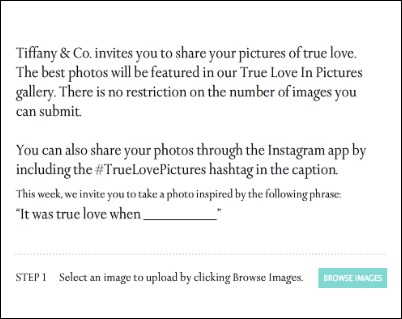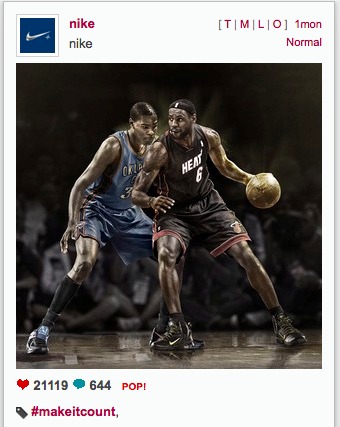5 brands that are Instagram superstars
Tom Edwards
The power of services like Instagram and Pinterest is in the simplicity and ease of publishing and pinning, as well as the deep integration of each into users’ social graphs. Pinterest has reaffirmed consumers’ interests in visually searching for information. Meanwhile, Instagram embodies the convergence of mobile and social.
Instagram now boasts more than 50 million users, and it is adding new ones at the rate of roughly 5 million per week. More than 1 billion photos have been uploaded on Instagram, with 5 million-plus more photos being added every day.
By enabling connections with other social platforms, making sharing easy, and focusing on discoverability of content via hashtags, brands have found innovative ways to incorporate Instagram into their social strategies to further humanize their brands. Brands that understand and capitalize on visual storytelling across channels will ultimately reap the benefits and net higher levels of engagement.
This article highlights five brands that have incorporated visual imagery and social curation via Instagram into their broader digital strategies. Each brand offers a different value proposition to its followers, but there are common themes demonstrated by each example. Let’s take a look.
American Airlines
American Airlines’ recent “Get Mobile Get Moving” campaign amplified the premise that travel and visual imagery are closely connected.
I recently spoke with Nowell Upham, EVP of consumer engagement at The Marketing Arm, to discuss the program. He noted, “Every brand has a story to tell. Rather than tell people American’s story, we wanted them to imagine it in the context of their own lives, so it would have even greater and lasting meaning.”
American Airlines published a weekly photo theme and invited users to submit photos via Instagram and other owned social channels with the hashtag #AApic.
Selected images were then featured on American’s Facebook brand page and a brand microsite photo gallery.
Every image submitted also served as an entry to win weekly prizes and a larger grand prize sweepstake.
The visual images associated with the themes provided a more-compelling call to action and structure for consumers to create content on behalf of the brand. That content was also contextually relevant to the individual participating versus a standard promotional call to action. Ultimately, the American Airlines program netted more than 69,000 total photo submissions.
Red Bull
Red Bull has taken visual storytelling to new heights with its visually stunning content that reinforces the key attributes of the brand. Their owned social properties are impressive, with more than 315,000 followers via Instagram and more than 600 photos published.
Red Bull uses multiple hashtags that represent different types of content, such as #GivesYouWings, #shareyourwings, and #FlyingFridays. Going beyond its content stream and “liking” other images also reinforces engagement by humanizing the brand.
Red Bull has also created a branded hub for sharing images tied to its products. At ShareYourWings.RedBullUSA.com, fans of the brand can share via the #shareyourwings hashtag across Twitter, Facebook, Instagram, and Tumblr in exchange for free products.
Incorporating product into the content in a relevant manner drives a stronger association with both the product and the activity in the image, thus reinforcing the brand promise.
Tiffany & Co.
Tiffany & Co. understands how visual storytelling can drive engagement for its brand. For Tiffany’s “What Makes Love True” campaign, Instagram played an essential role in creating the mood that ultimately is an extension of the brand.
Instagram has iPhone hooks that allow any other iPhone application to interact with the Instagram application. So if a brand wants to create custom filters, it can build the functionality into its branded application and publish into the Instagram photo stream. As a way to provide value and differentiate its iPhone app, Tiffany’s incorporated three new Instagram filters. Users were treated with black and white, peach, and Tiffany blue.
The images inspired from the campaign are posted to “True Love in Pictures.”
Users simply tag their photos through the Instagram app by including the #TrueLovePictures hashtag in the caption.
By leveraging Instagram’s built-in hooks, Tiffany’s was able to create additional value for the consumer through a complementary extension of its brand.
Ford
Ford’s focus (no pun intended) on visual imagery powering the brand is evident in its recently executed “Fiestagram” program rolled out to European markets. The campaign challenged Instagram photography enthusiasts to upload photos in several categories inspired by the technologies and features of the Ford Fiesta.
Each week, Ford communicated the weekly challenge as a hashtag associated with technology related to the Ford Fiesta.
Participants could interpret the categories in any way they saw fit and use any of the filters and effects available on Instagram to enhance the mood of their images. Running on the Ford Fiesta Facebook page, contestants could enter simply by uploading photos with the hashtag #Fiestagram and #(weekly challenge) via Instagram captions.
All images submitted appeared in online galleries on Facebook, and some of the best submissions also appeared on billboards and in real-world photography galleries across Europe.
A total of 16,000 pictures were submitted, with 12,000 new Facebook fans gained during the course of the promotion.
Nike
Nike’s “How will you #MakeItCount in 2012” campaign takes the traditional New Year’s resolution and turns it into a rallying cry to motivate and inspire individuals to meet and exceed their goals via visual imagery.
Nike has enlisted the help of superstar athletes like Lebron James, Kobe Bryant, and Dirk Nowitzki as catalysts for sparking the #MakeItCount movement.
Since launching in January, more than 41,000 Instagram images have been tagged with the #MakeItCount hashtag.
By staying true to its core brand attributes, Nike’s call to action and the imagery that it evokes become the visual embodiment of the brand. That is carried forward as a virtual representation of both the brand and the individual.
Other noteworthy players
There are many other brands making an impact with Instagram-generated content, including Pepsi, Starbucks, Burberry, Volkswagen, Warby Parker, Puma, and Maersk. The top five most-followed brands on Instagram are:
1. MTV — 768,563 followers
2. Starbucks — 704,731
3. eOnline — 616,248
4. Victoria’s Secret — 442,265
5. Burberry — 442,587
With Facebook’s recent purchase of Instagram and the launch of its own photo-based app, no one quite yet knows what the future will hold for Instagram. But with numbers continuing to grow across the board, Instagram is not looking to slow down any time soon.
Regardless of the platform, visual storytelling and social curation are now at the core of the social experience. Brands that can incorporate user-generated images that are relevant to both the brand and the individual will find the most engagement and potential for activation.
Close














